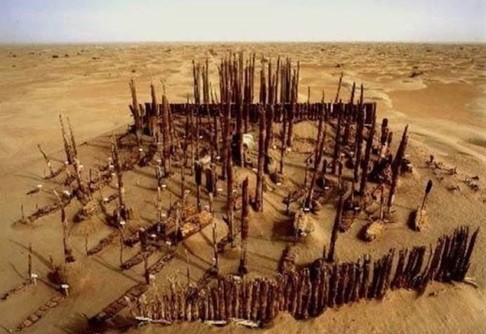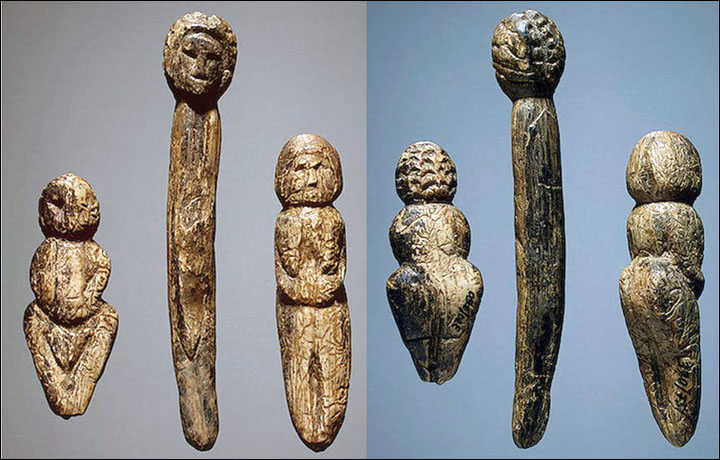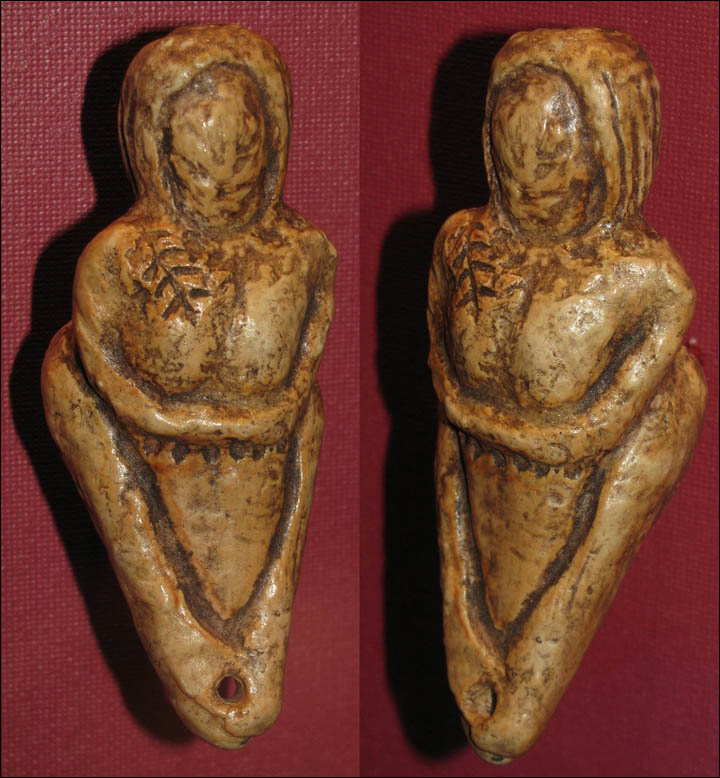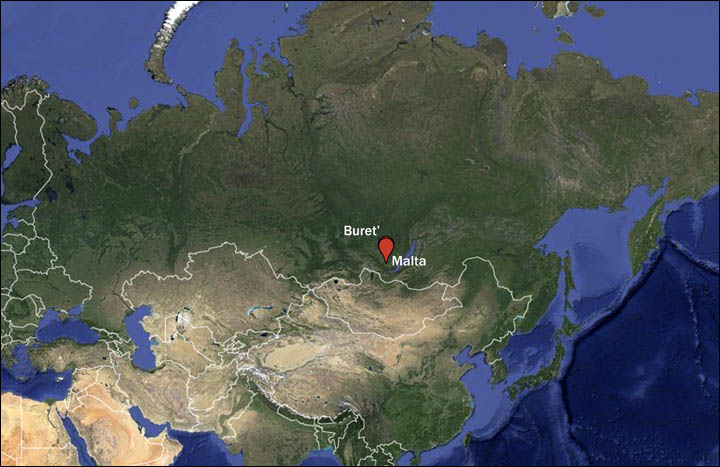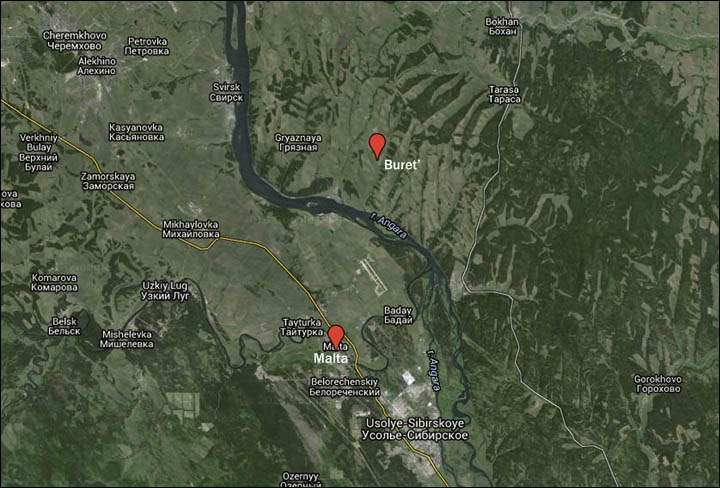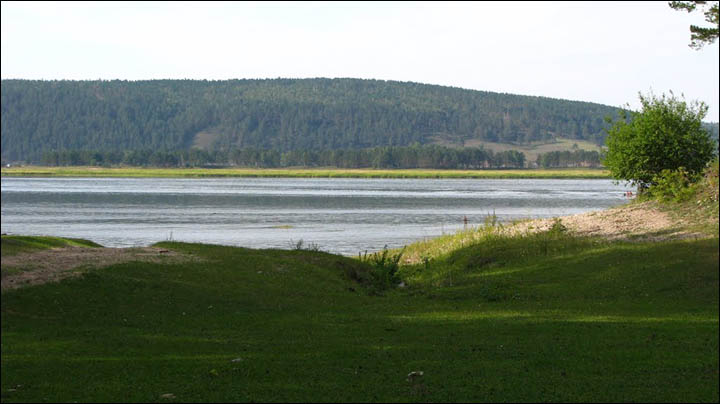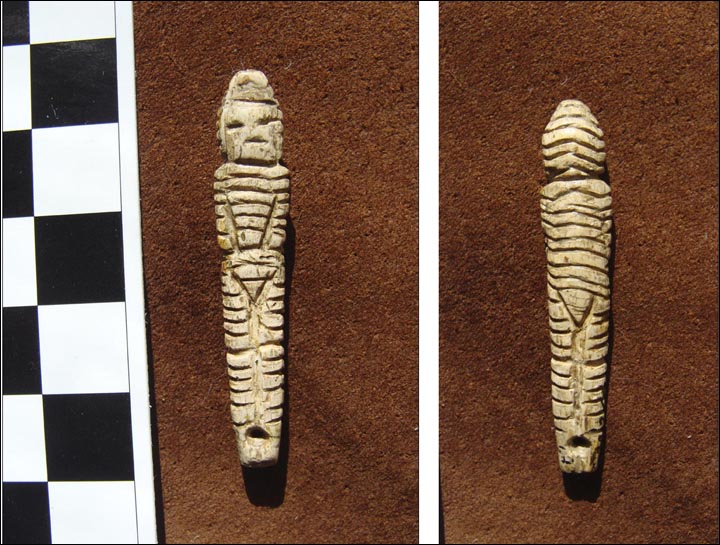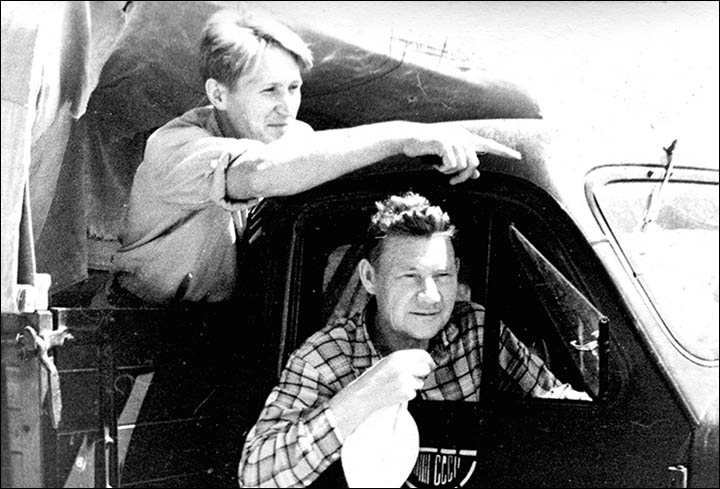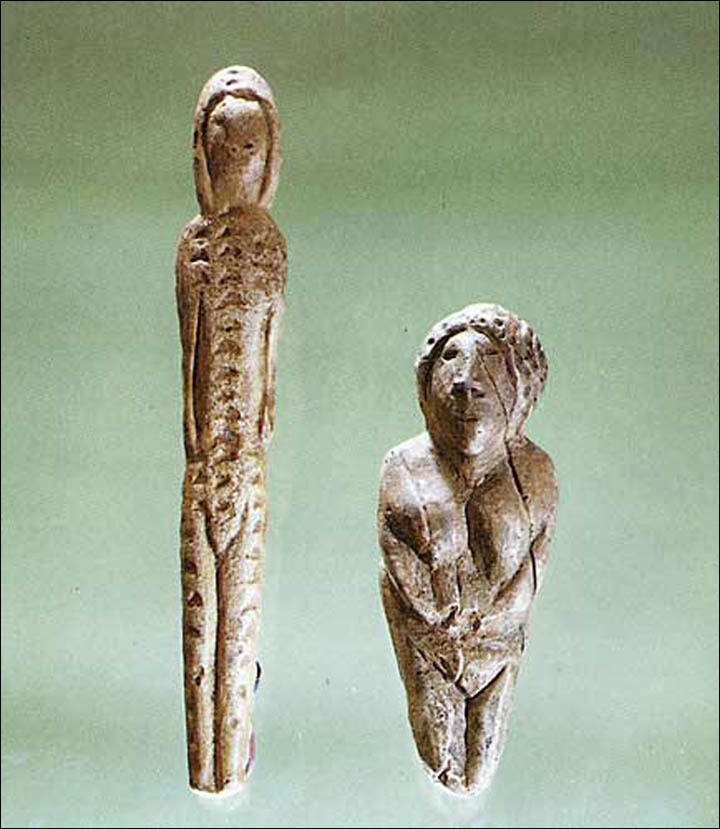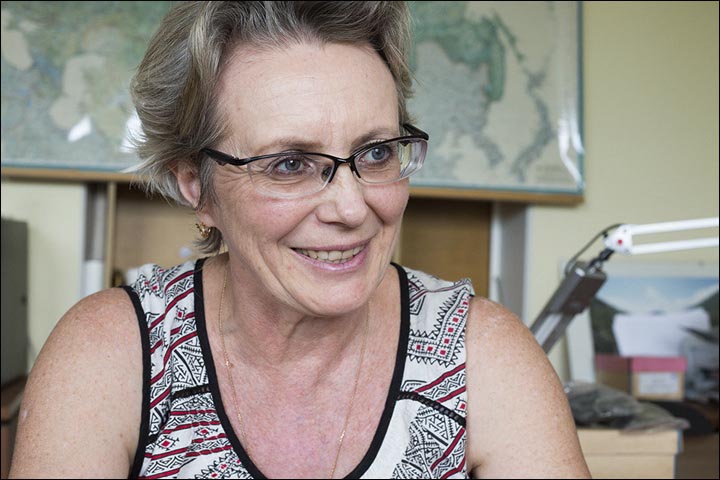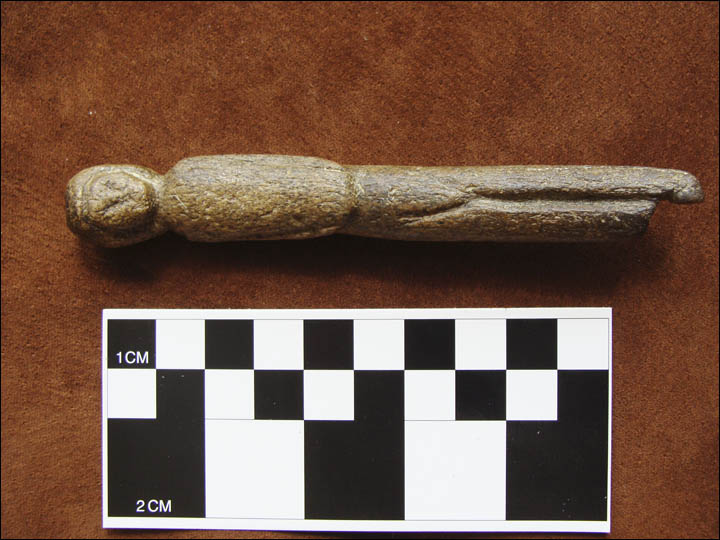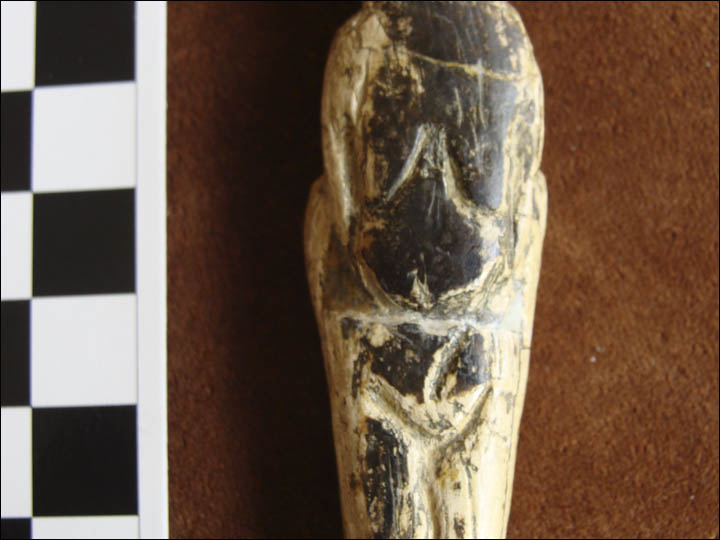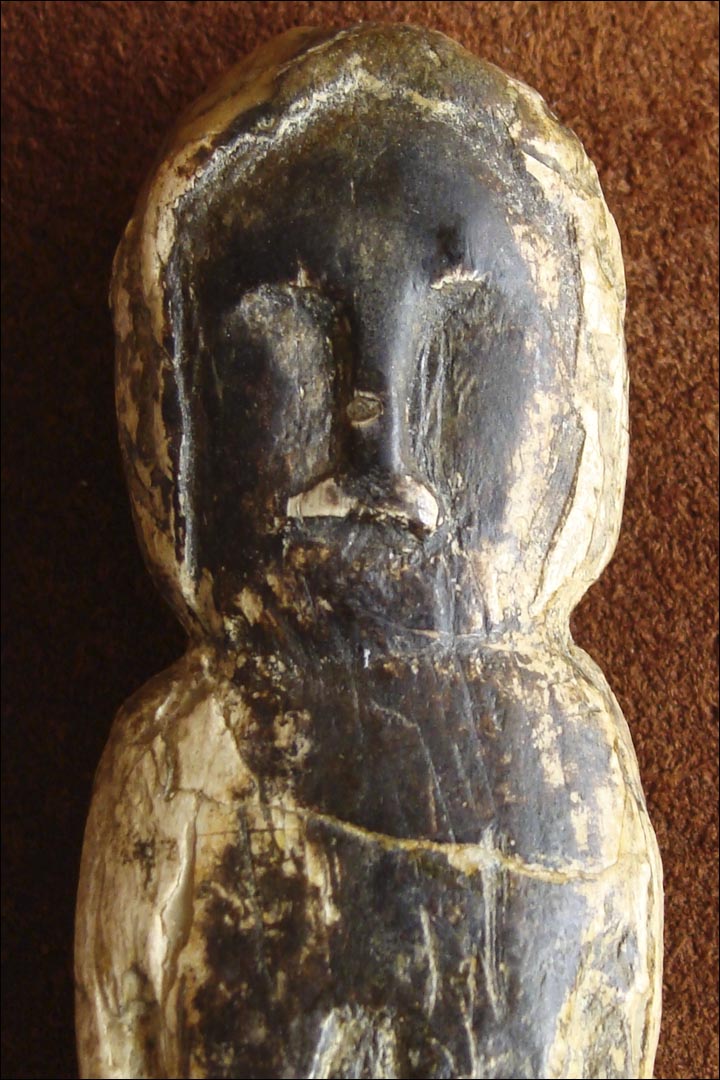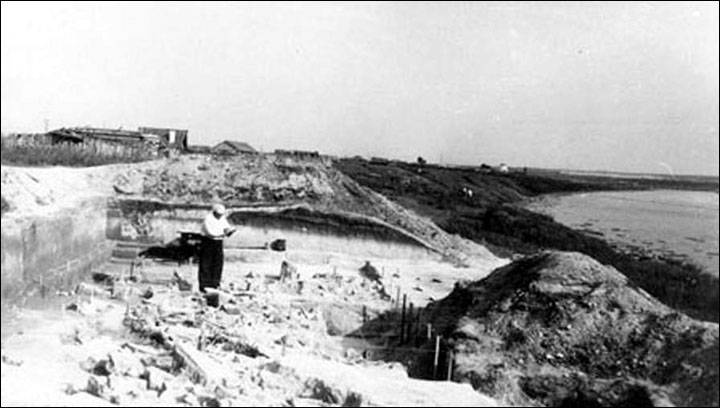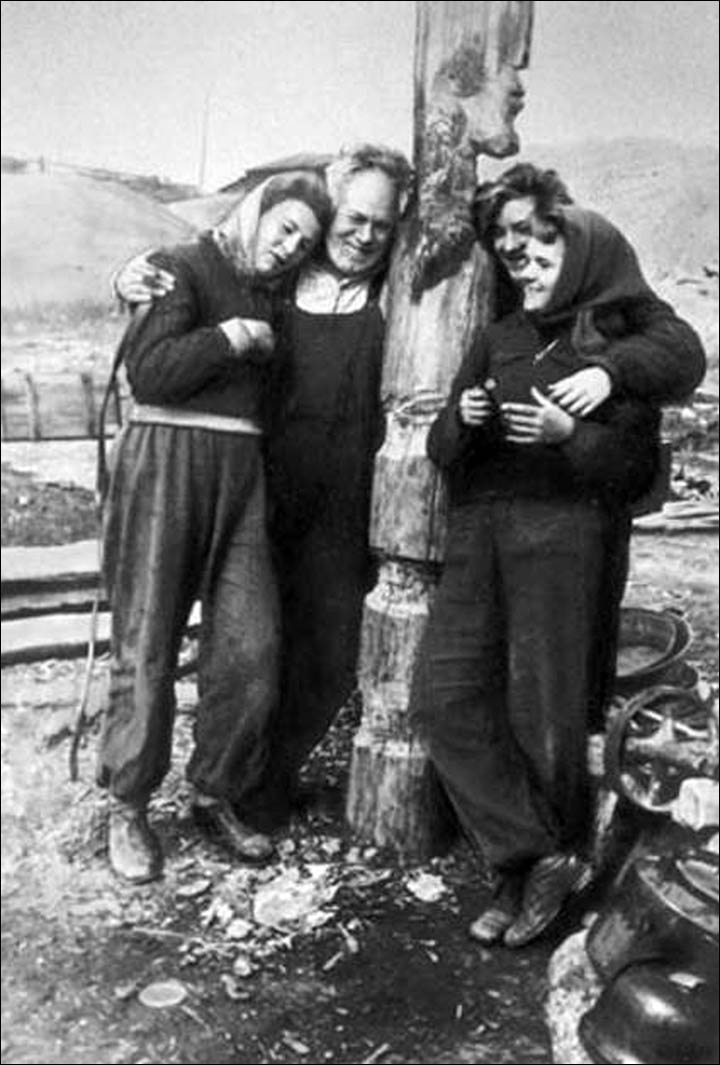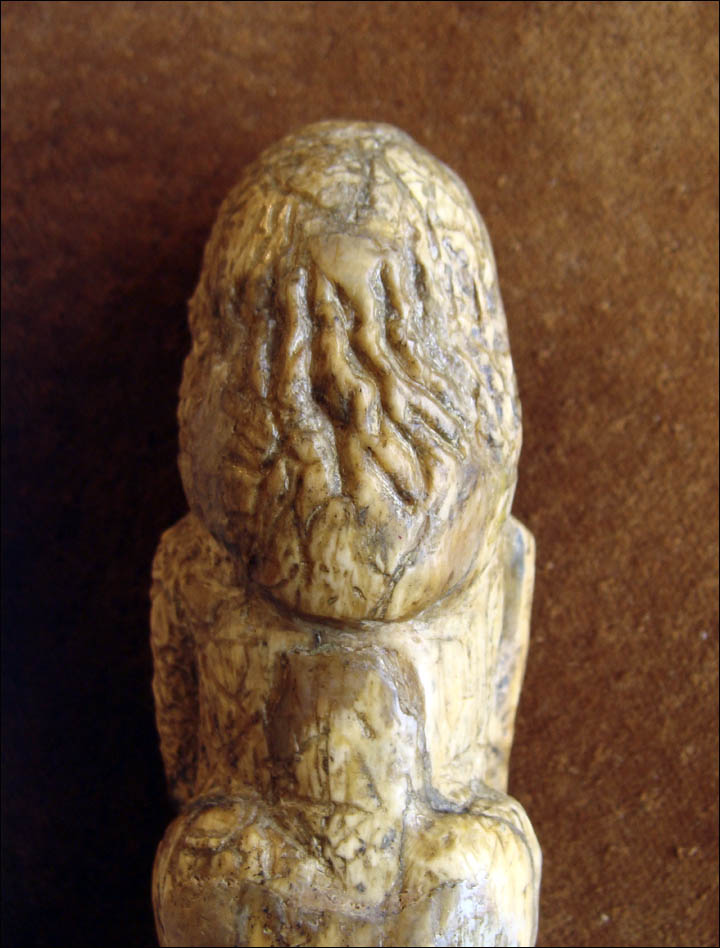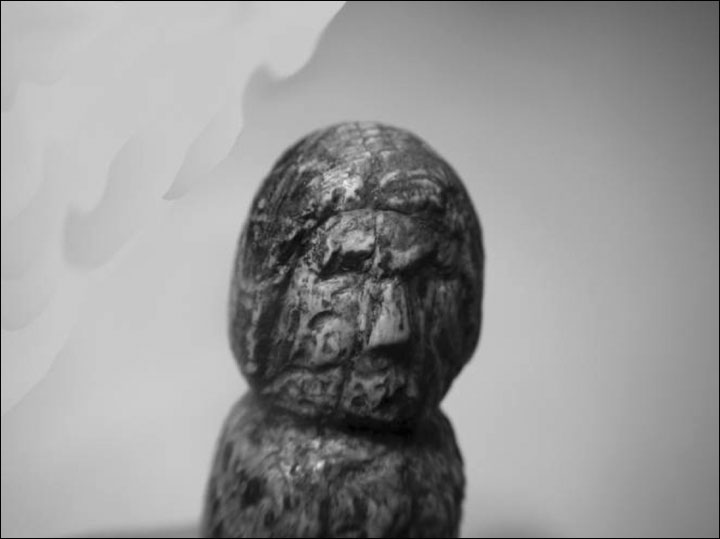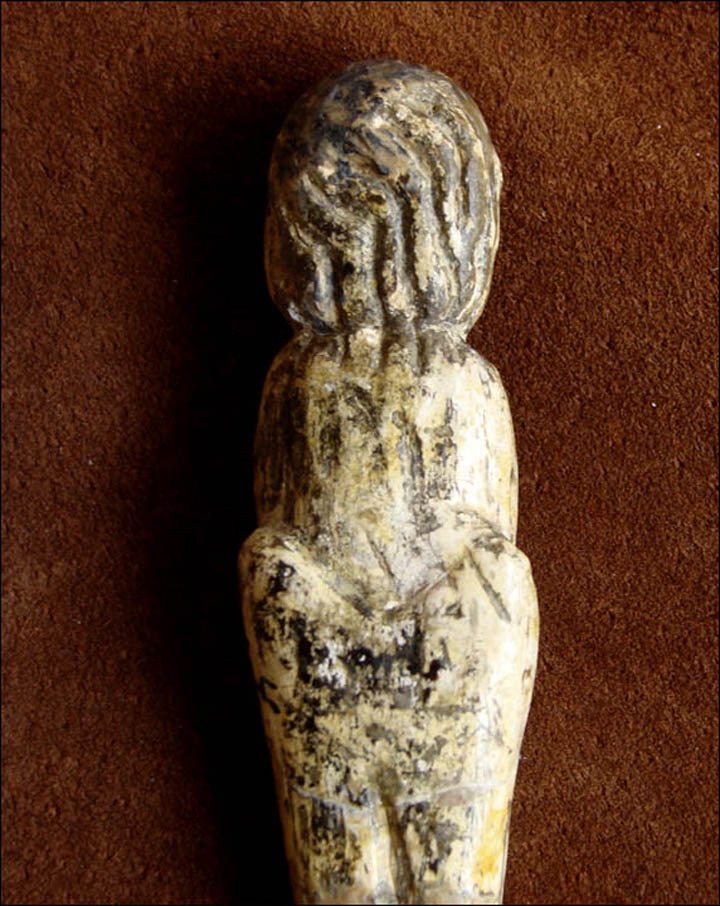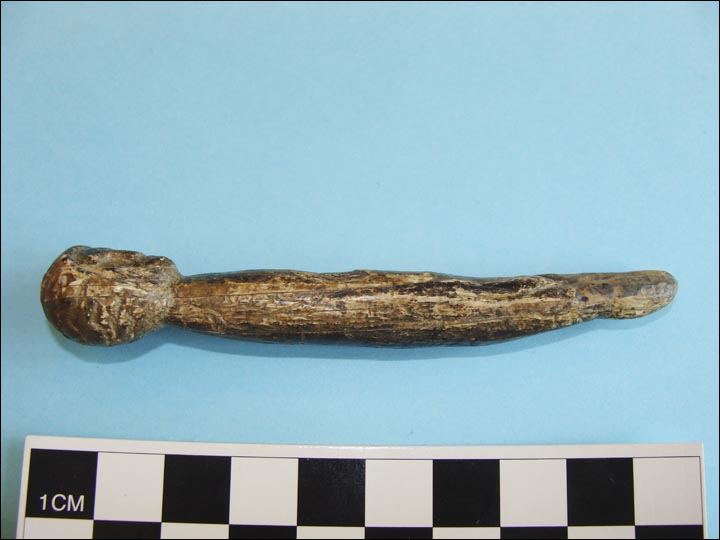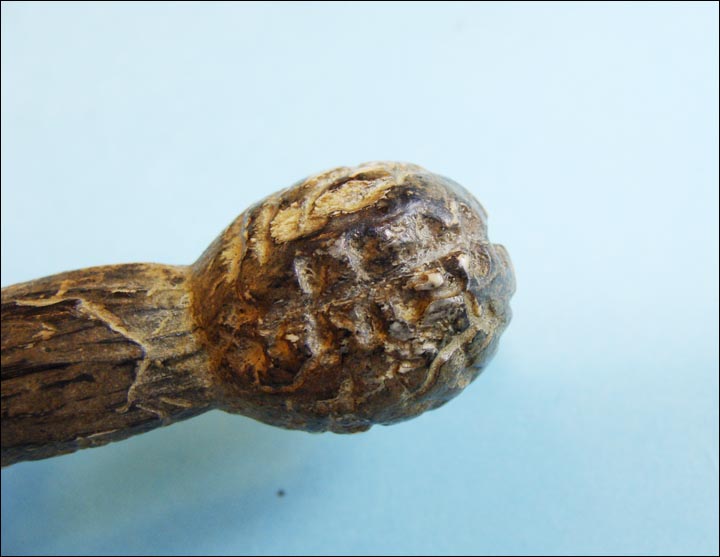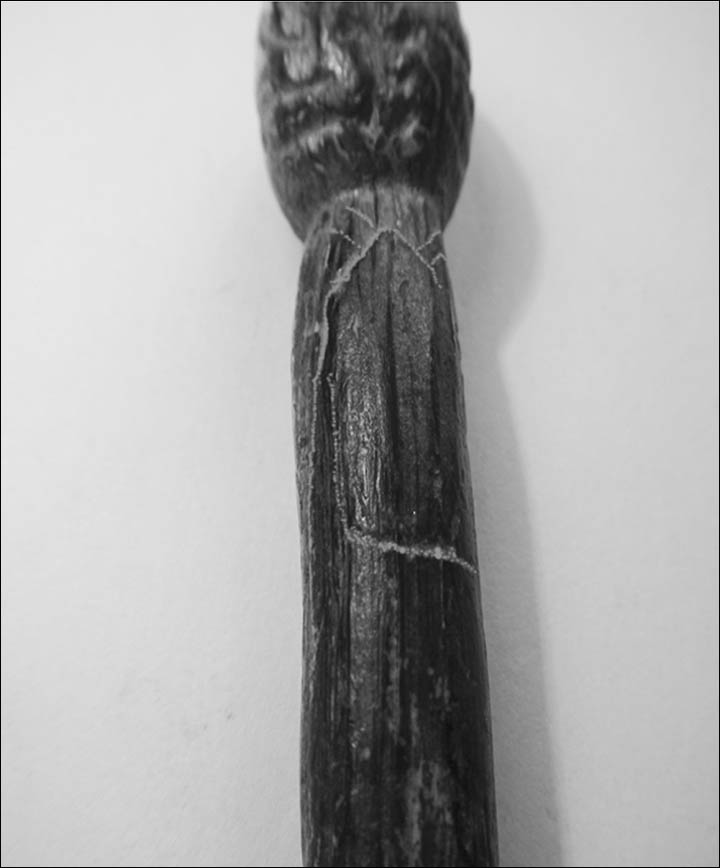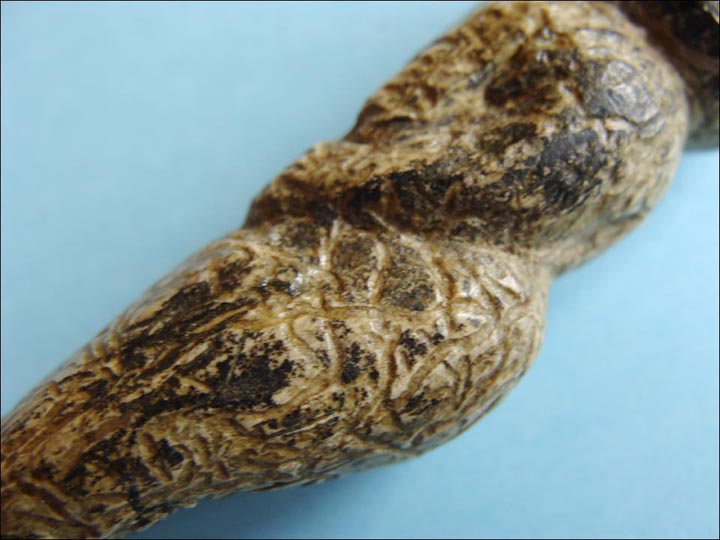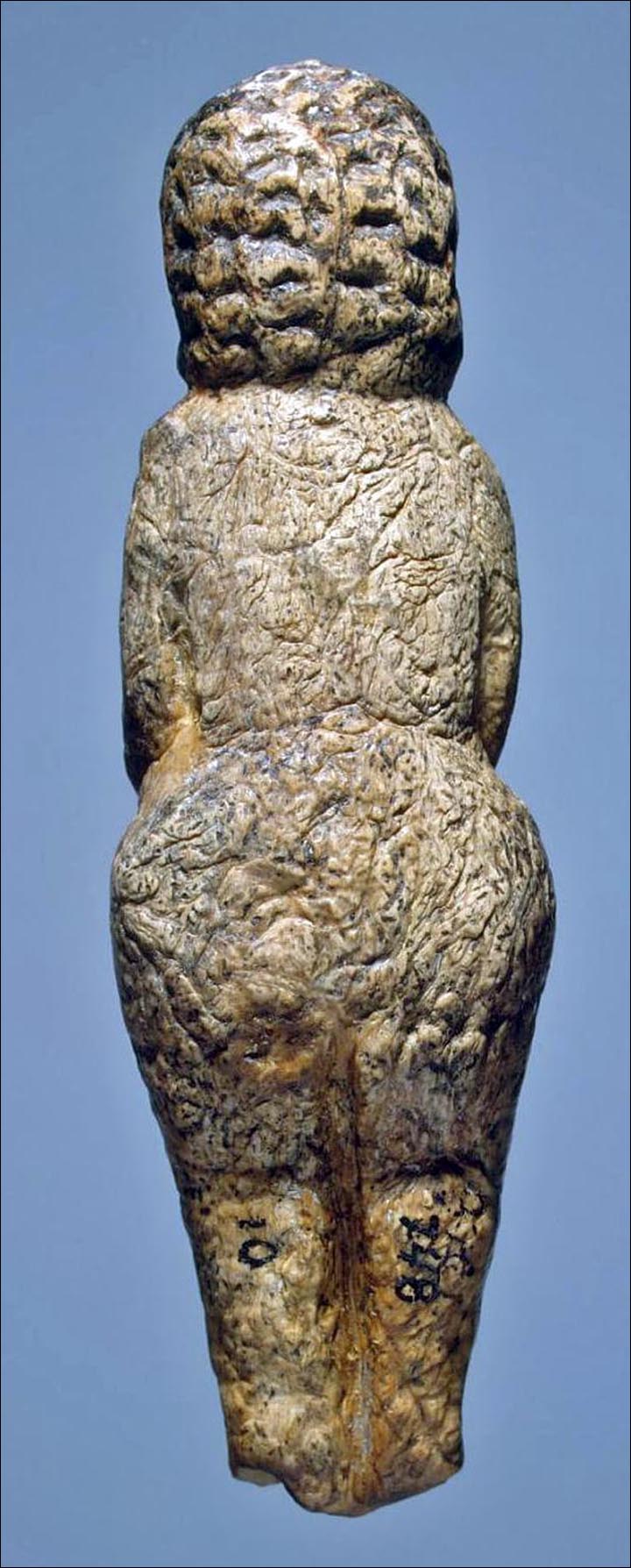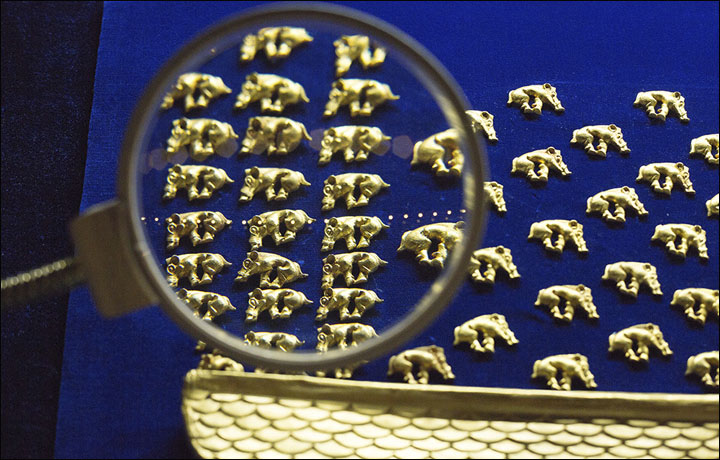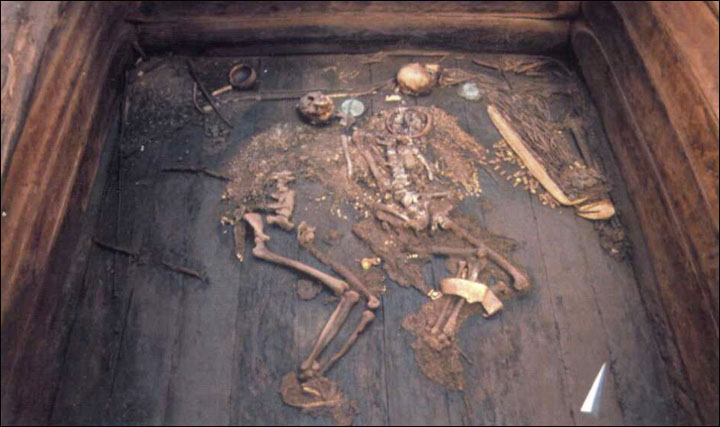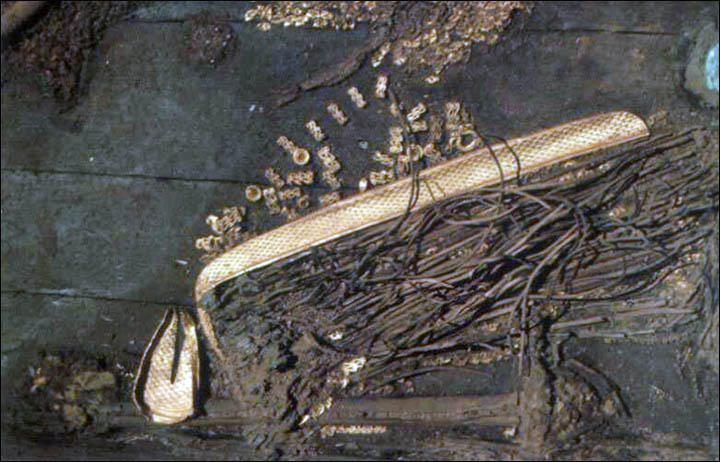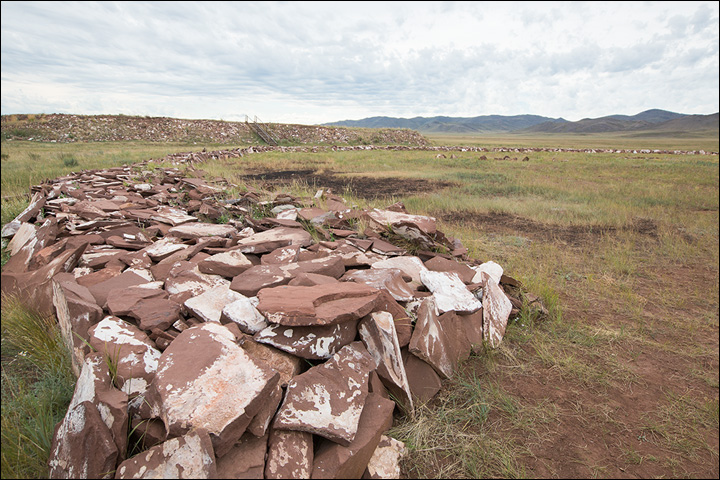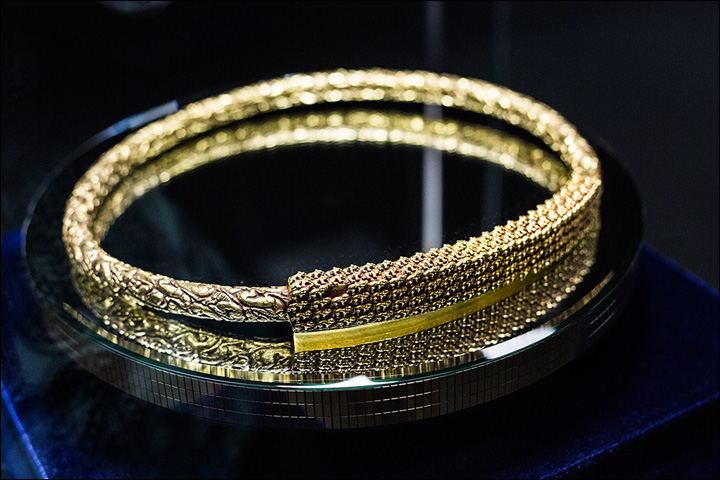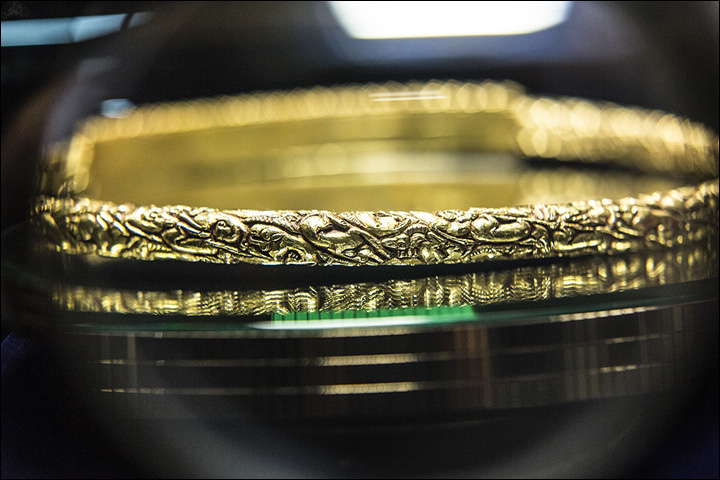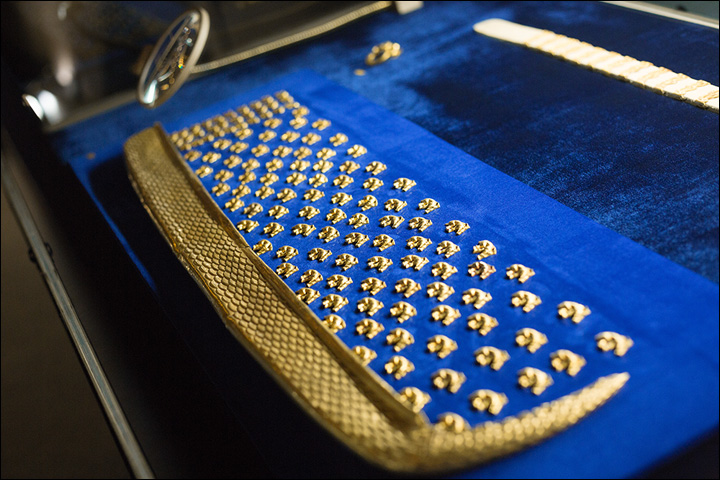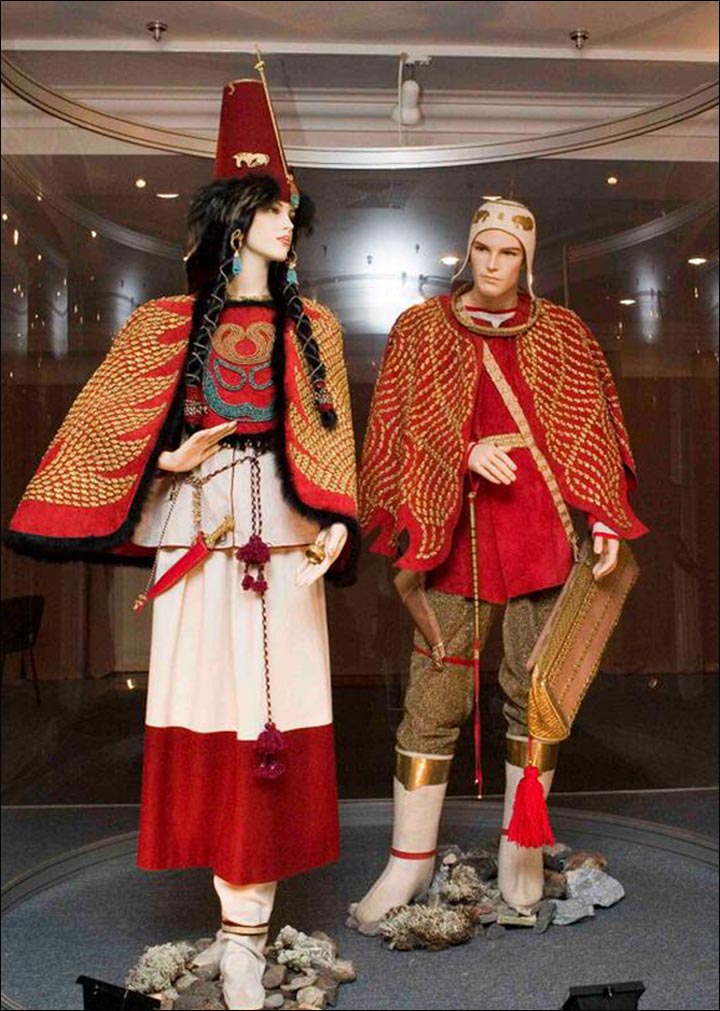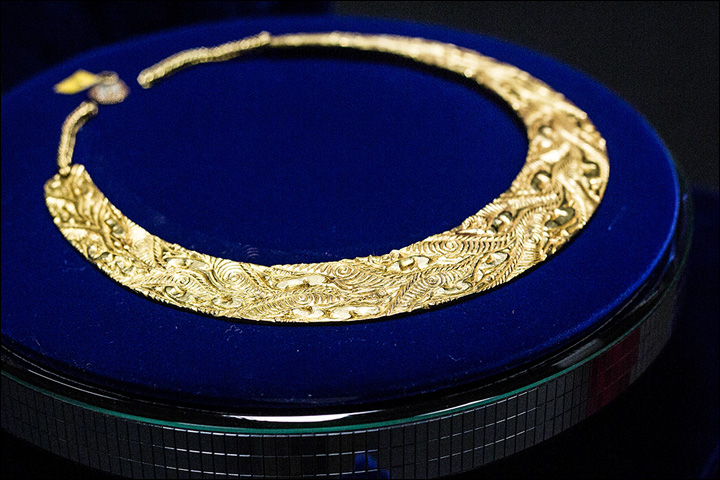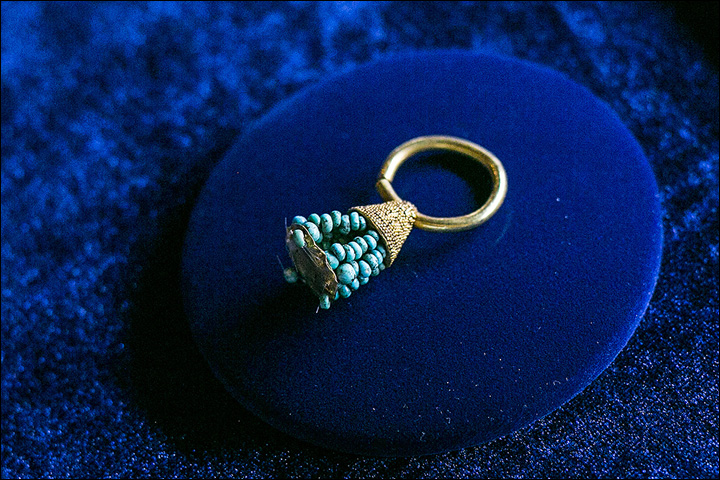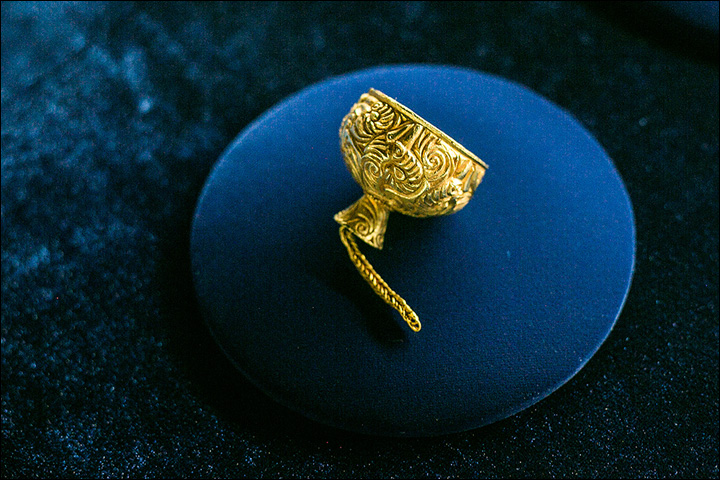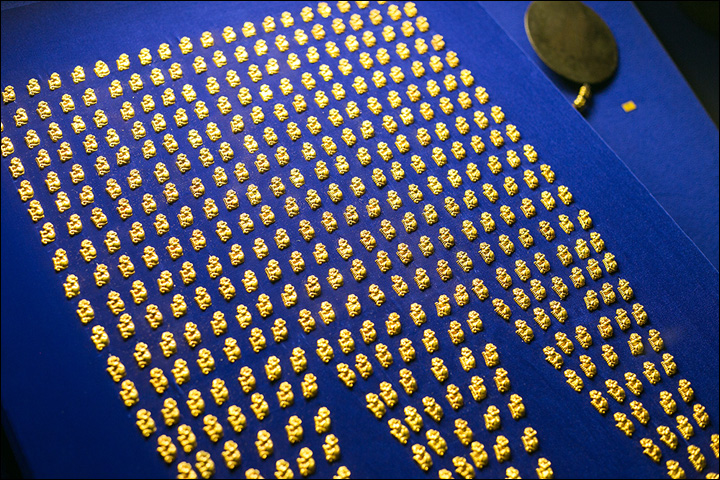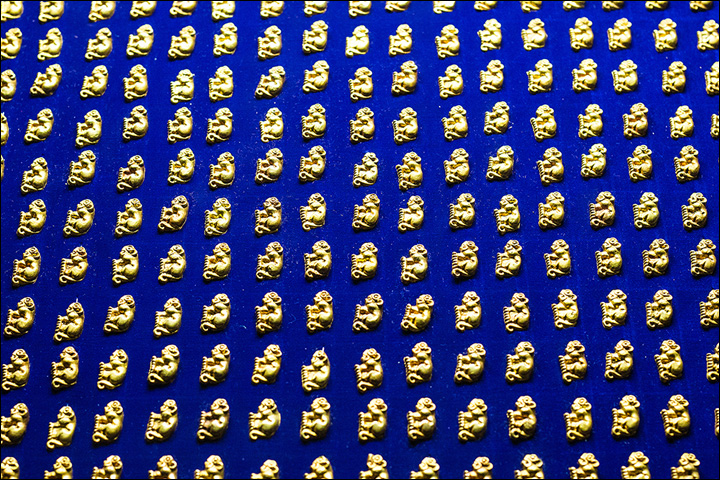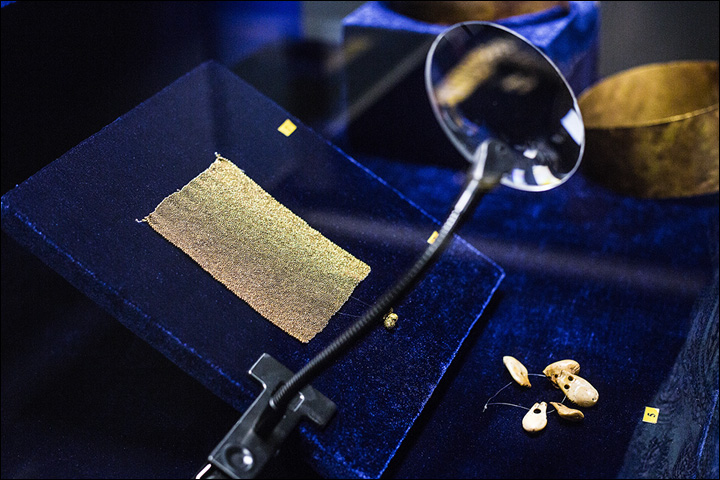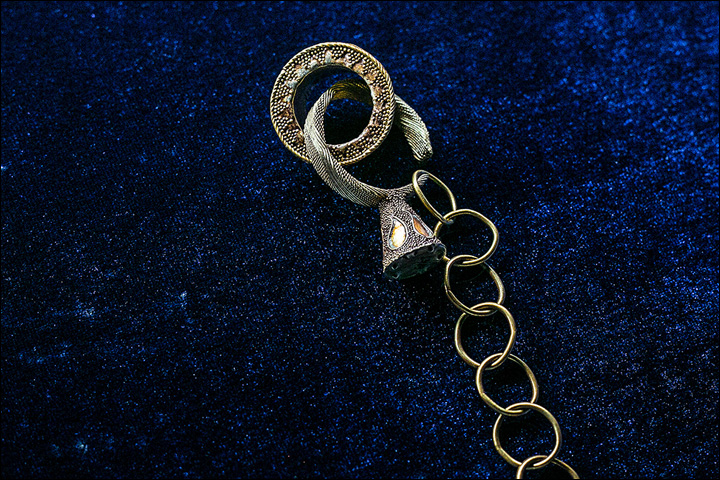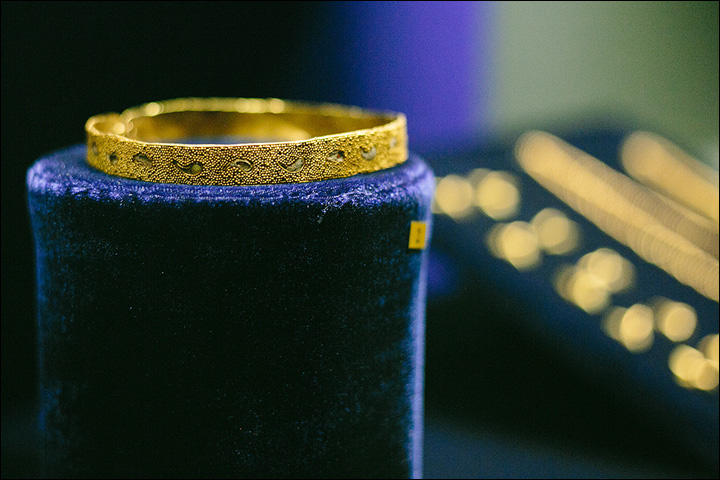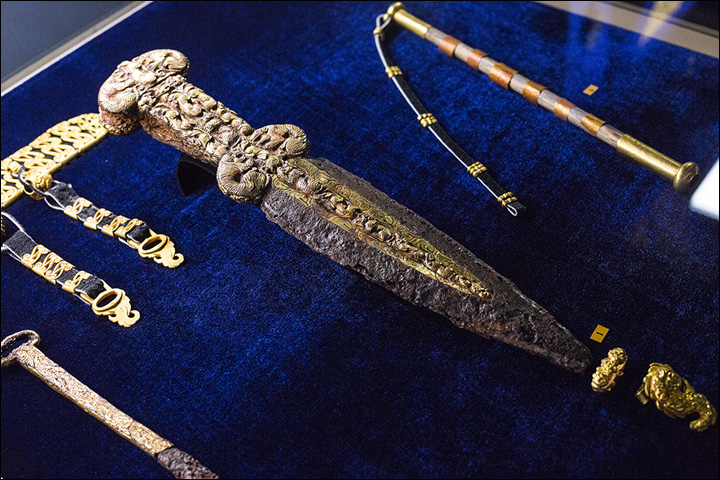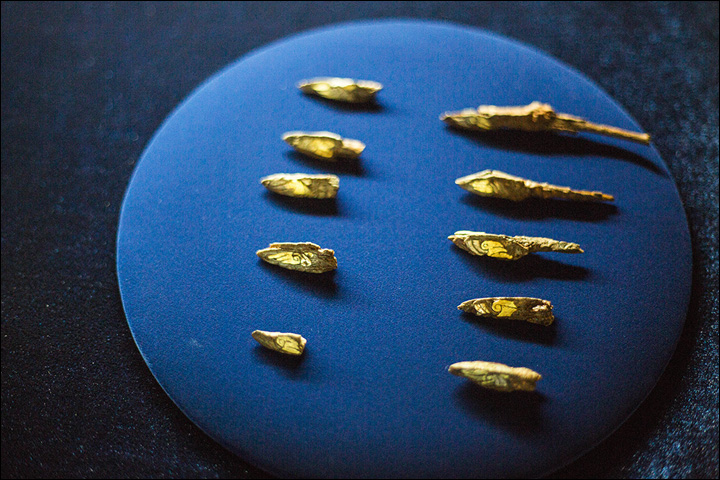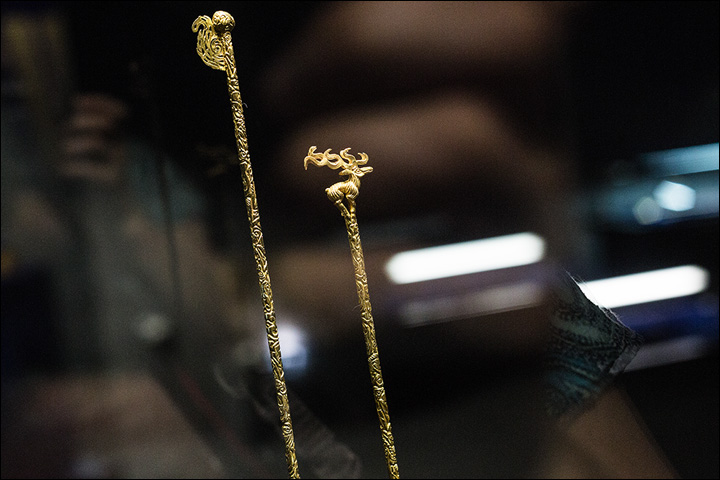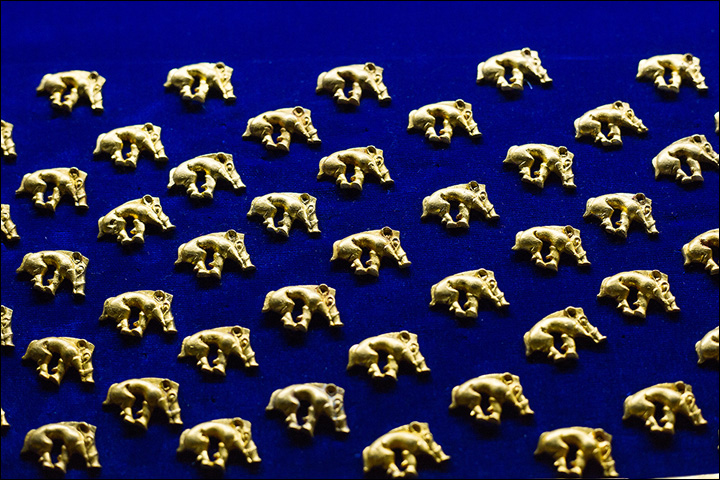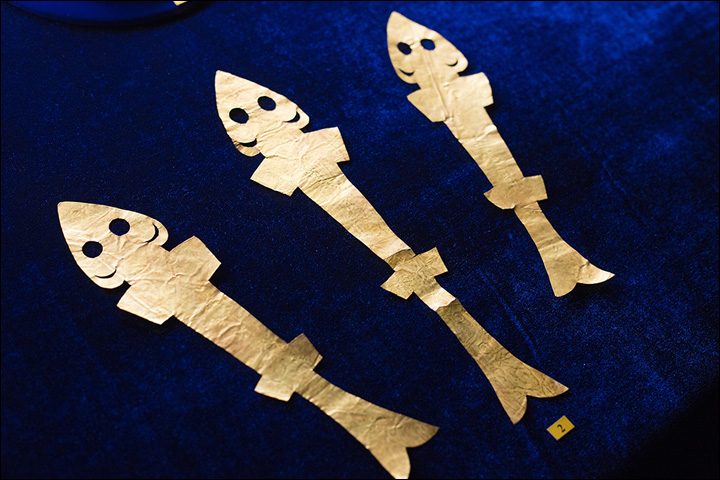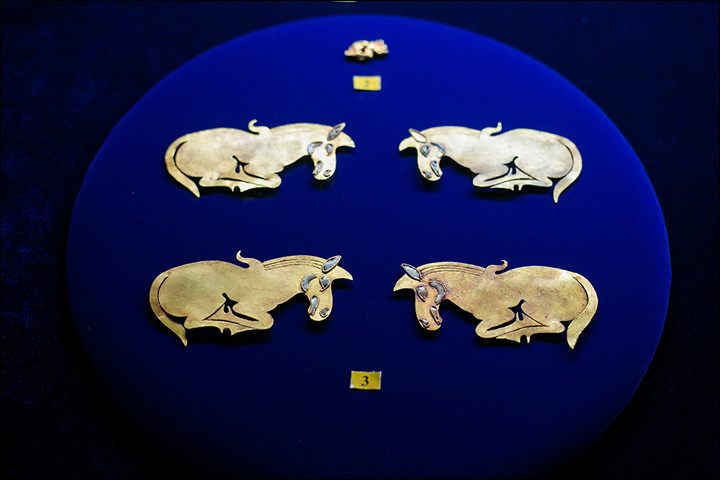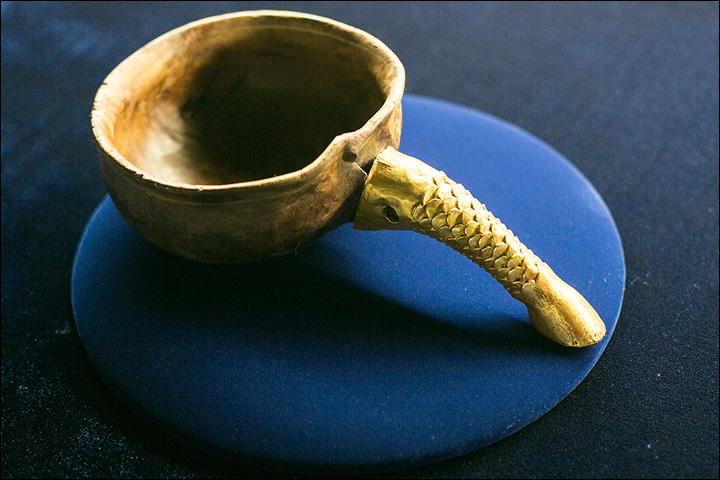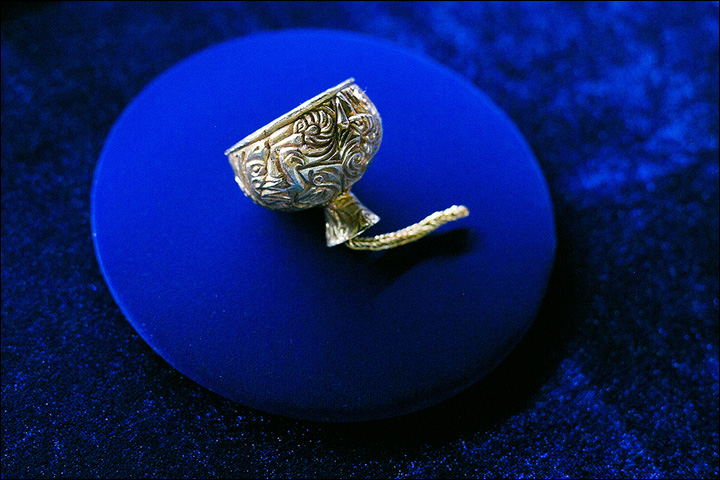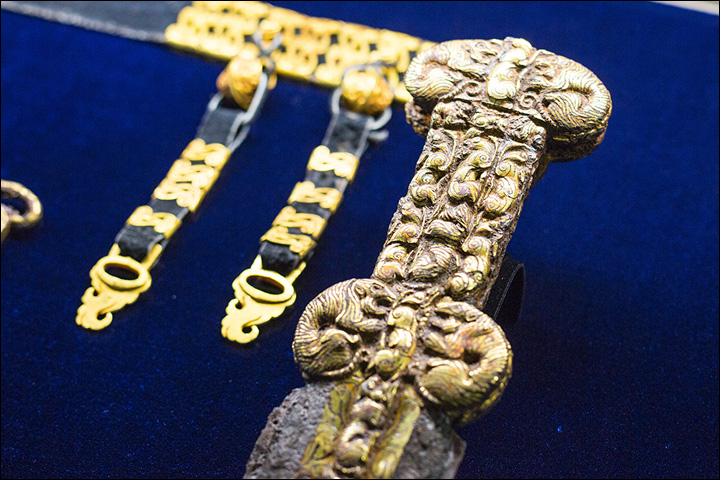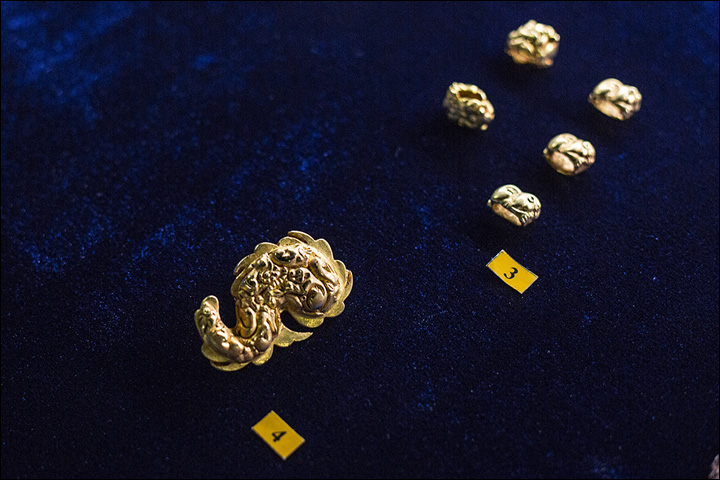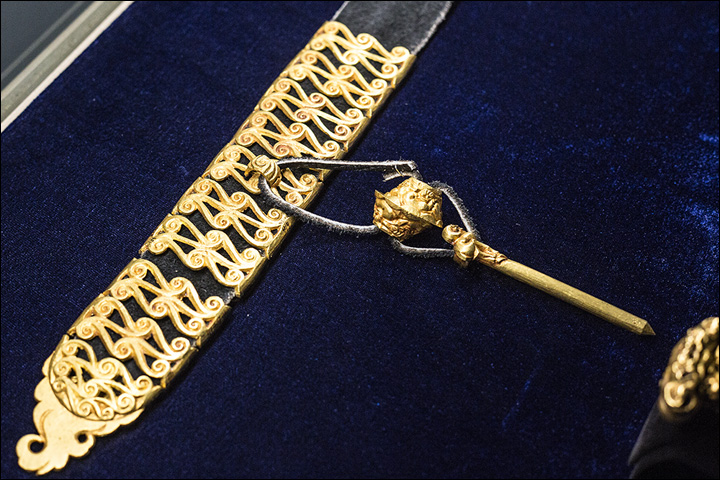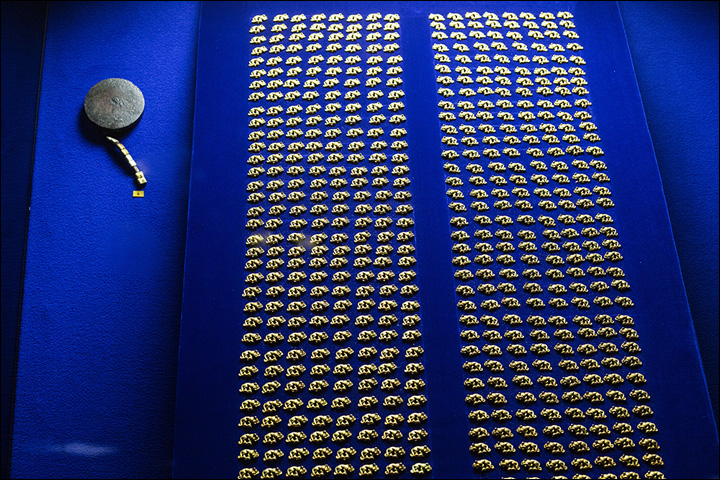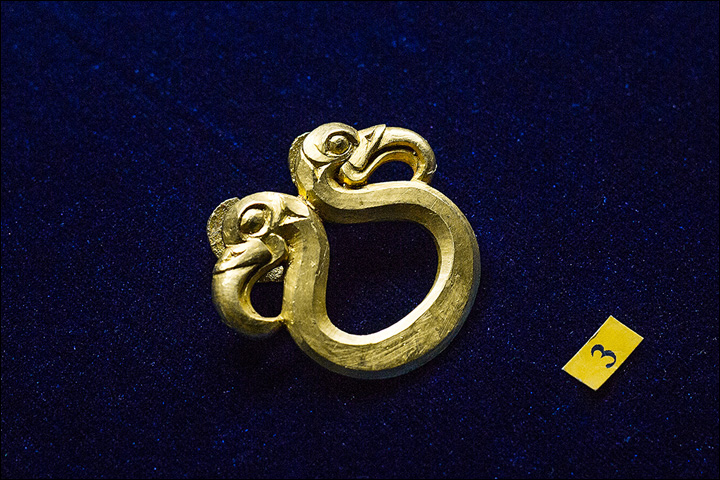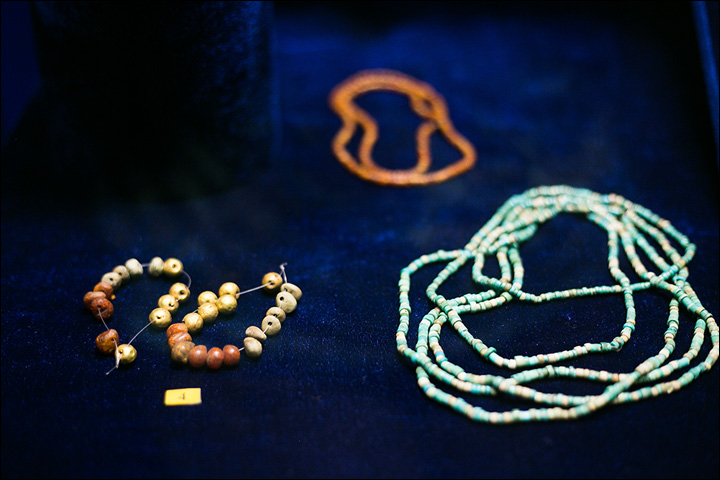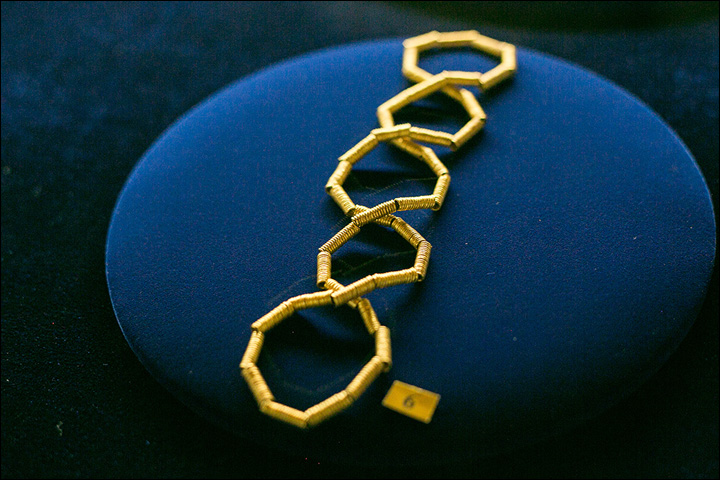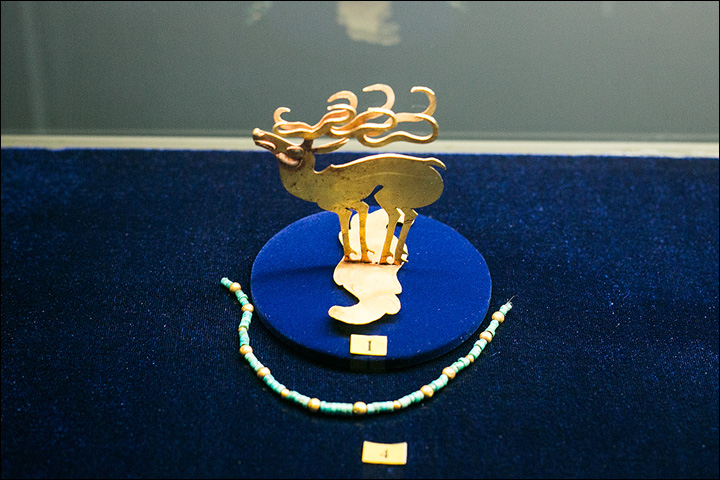In all, some 9,300 decorative gold pieces were found here, not including the 'uncountable golden beads'. Picture: Vera Salnitskaya
The royal tomb known as Arzhan 2 in the modern-day Republic of Tuva - to many, the most mysterious region in all Russia - is some 2,600 years old but its valuables match any trove from any era anywhere in the world.
Here inside a mound 80 metres wide was buried a warrior tsar with a sway that plainly reached over a vast territory of mountains and steppes, and whose magnificent possessions indicated close contacts with other civilisations.
Forget the notion of barbaric Siberian nomadic tribes in this epoch: well, don't quite forget. These ancient warriors used the skulls of their vanquished foes as drinking cups, according to no less an authority than Greek historian Herodotus.
And this queen or concubine was almost certainly sacrificed to that she could be buried beside the dead ruler. And yet, as the pictures show, their exceptional artwork predates the influence of the Greeks, and displays a high degree of sophistication.
Unknown warrior was found literally covered in gold alongside with his woman. Pictures: Konstantin Chugunov, Anatoli Nagler and Hermann Parzinger; Vera Salnitskaya
The unknown monarch - a Siberian Tutankhamun - was entombed in this ancient necropolis with 14 horses, a defining symbol of wealth in these Scythian times; each animal was from a different herd.
Alongside him lay the woman in his life, his queen or, as is suspected, his favourite concubine, but in any event a woman held in great esteem who was ethnically distinct from this monarch's retinue also buried alongside him which included 33 others, including five children. She was in all likelihood not alone in being sacrificed to accompany him to the afterlife...
The most breathtaking aspect of this Tuvan find are the contents of the burial chamber of this royal couple - pictured here - located by archeologists some two or three metres beneath the surface.
In all, some 9,300 decorative gold pieces were found here, not including the 'uncountable golden beads'. Put in another way, there was more than 20 kilograms of gold, including earrings, pendants and beads, adorning the bodies of the royal couple all made in what is known as Animal Art style.
The ancient ruler was buried with a heavy necklace made of pure gold and gold quiver with fish scale decoration. Pictures: Vera Salnitskaya
Ancient robbers had sought to raid vast burial mound, just as they had successfully looted the neighbouring Arzhan 1 site, which was perhaps 150 years older. It could be that specially built 'decoy' graves threw these ancient looters' off the scent.
Here in Arzhan 2, thieves had left a trail which archeologists unearthed but fortunately the raiders gave up shortly before reaching these treasures, which are made from iron, turquoise, amber and wood as well as gold.
So valuable are they that it is rumoured these wondrous objects - now held mainly in local capital Kyzyl but also in St Petersburg - cannot be exhibited abroad because of the cost of insurance.
The find has been described by Dr Mikhail Piotrovsky, director of the Hermitage Museum as 'an encyclopedia of Scythian Animal Art because you have all the animals which roamed the region, such as panther, lions, camels, deer...' It includes 'many great works of art - figures of animals, necklaces, pins with animals carved into a golden surface', he told The New York Times.
'This is the original Scythian style, from the Altai region, which eventually came to the Black Sea region and finally in contact with ancient Greece. And it resembles almost an Art Nouveau style.'
The reconstruction of the costumes made by the experts from Hermitage Museum. Picture: Hermitage Museum
Covered with two layers of larch logs, the royal burial chamber was carefully constructed like a blockhouse and stood inside a second, outer burial chamber of the same construction.
The four walls were presumably adorned by some kind of curtain. Long wooden sticks were found along the walls, which could have been used like curtain rails. The curtains themselves, as well as any other textile remains, were not preserved. On a carefully made boarded wooden floor - likely softened by felt - were the bodies of this sovereign and his companion.
The skulls had dislocated from the bodies because they had probably been placed on a kind of pillow, now decayed. The ancient ruler was buried with a heavy necklace made of pure gold and decorated all over with the carvings of animals.
His outer clothes, probably a kind of kaftan, had been decorated with thousands of small panther figures, each 2-to-3 centimetres in length, attached in vertical rows, also forming motifs such as wings on his back.
A gold pectoral in Animal Style decoration, golden earring with turquoise and a miniature gold cup. Picture: Vera Salnitskaya
On his boots, maybe originally of felt or leather, thousands of mini-beads - in diameter only about 1 millimetre - had been stitched; on the upper part they ended in golden turndowns. Alongside and under the skull were gold plaques with animal-shaped inlays: four winged horses and one deer originally attached to the headgear.
The total weight of his jewellery - including minute glass beads on his trousers - was 2 kilograms. The man's weaponry consisted of an iron dagger, poorly preserved, on his right hip. This was connected to the belt by a strap, and both had been decorated with numerous golden adornments.
Beside the dagger was a miniature gold cup. On the left side of the deceased was a gold quiver with fish scale decoration. The wooden arrow shafts were painted in black and red. His arrow heads were made of iron, but also showed the remains of golden encrustation. The golden adornment on the belt - used for carrying his quiver into the afterlife - was extremely rich.
Below the quiver lay the wooden bow itself, studded with pieces of golden decoration. Between the quiver and the north-eastern wall of the burial chamber were two picks, one of iron with golden encrustation. To the left of the man's head lay a bronze mirror.
His outer clothes, probably a kind of kaftan, had been decorated with thousands of small panther figures, each 2-to-3 centimetres in length. Pictures: Vera Salnitskaya
A second, slightly larger bronze mirror was located to the left of the woman's head, a little bigger and with a gold handle. Below the woman's head were three gold plaques in the shape of animals - two horses and a mystical winged creature - associated with the woman's headdress.
Beside her head was a pair of gold pins, decorated with carvings in Animal Art style. The decoration of the woman's dress corresponded to the man's kaftan: thousands of golden panthers form different motifs, again, notably, wings on her back. Around her breasts, archeologists found golden earrings and many small beads of gold, amber, garnet, malachite and other precious materials.
Near her feet were thousands of mini-beads made of gold, which must have been fixed onto felt or leather boots which had been inlaid with golden ribbons and granulation.
On her right hip hung an iron knife, poorly preserved but with numerous excellent gold belt adornments. Her wrists were adorned with gold bracelets. Here, too, lay two bronze kettles, seen as exceptionally valuable for these times.
In the western corner of the burial chamber were three large amber beads, a wooden cup with a golden handle, a gold comb with wooden teeth, and a heap of various seeds. Within the heap of seeds was a gold pectoral in Animal Style decoration and a small bronze cup, still inside a small leather bag.
'It's hard to imagine that these fine pieces were made by nomads living in tents.' Pictures: Vera Salnitskaya
In other burials, which surrounded the prominent couple, bronze knives, an axe-type weapon, known as a Raven's beak, arrowheads, bronze mirrors, belts, and much jewellery - beads made of glass, stone, amber, and golden earrings - were found. So too were fragments of cloth - felt, fur, and fabric.
Here too were discovered bridle sets made of bronze, mane ornaments and tail decorations cut from gold sheet.
What can we discern of the personal stories behind these ancient royals and their entourage found in Uyuk hollow, northern Tuva, and excavated by a joint Russian-German team between 2001 and 2004?
Professor Konstantin Chugunov, highly respected senior researcher at the world famous Hermitage Museum in St Petersburg, who headed the project, said DNA analysis of the group indicated those buried here were from the Iranian ethno-linguistic group.
According to the analysis of strontium isotopes in the bones, all those buried were locals except for one person - the 'queen', and it gives reason to think about dynastic marriage,' he said.
Weapon: an iron dagger and iron arrowheads with golden encrustation. Pictures: Vera Salnitskaya
Totally 35 people - 16 men, 13 women, five children along with bones which cannot be identified by gender, were buried here, as were 14 horses.
The 'king' was between 40 and 50 years old and analysis of his remains revealed that he died of prostate cancer. 'This is the earliest documentation of the disease,' said Michael Schultz, a paleopathologist at the University of Gottingen. It is believed that in the last years of his life, this potentate could not have walked.
His female partner, accorded pride of place alongside him, was around 30 years old. Who was she?
We don't know if the woman was a queen or a concubine,' said Professor Hermann Parzinger, president of the Prussian Cultural Heritage Foundation, and a joint leader of the excavations, 'but since their ornaments were similar, both must have had high status.'
No cause of death can be detected for her, leading to a theory that she could have been poisoned or strangled, to be buried beside her liege, and to travel with him into the next world: willingly or not, she was a human sacrifice, according to this version.
'Maybe she was poisoned,' said Chugunov, 'or maybe she chose to die to be with her husband.' We may never know how she died, by natural causes around the same time as her master or in more sinister fashion, but others in the tsar's entourage certainly had gruesome demises.
Early Scythians were people who knew good artwork when they saw it, and used contacts to obtain, or commission, jewellery and decorations. Pictures: Vera Salnitskaya
The scene archeologists uncovered here appears to match with remarkable accuracy a description by Herodotus of the macabre Scythian burial rite.
'Based on accompanying burials, we also found evidence of phenomena described by Herodotus when the living would follow the deceased,' Parzinger has explained. 'Herodotus wrote that when a military leader died, his close circle - wife (or concubine), bodyguards, advisers, servants - were killed. As they were the property of the leader, they had to follow him to the tomb. And we identified particular evidence of their murder.'
Herodotus, who lived later, from 484 BC to 425 BC, wrote: 'The body of the king is laid in the grave, stretched upon a mattress. Spears are fixed in the ground on either side of the corpse and beams stretched above it to form a roof.
'In the open space around the body of the king they bury one of his concubines, first killing her by strangling, and also his cup-bearer, his cook, his groom, his lackey, his messenger, some of his horses... and some golden cups, for they use neither silver nor brass.'
It is believed that when the king died, he was mummified and his body travelled for 40 days across all his lands. And all expressed their sorrow. Then at some sacred place a burial mound was constructed and his entire entourage were slaughtered and buried there.
Cups: wooden cup with a golden handle and small golden cup. Pictures: Vera Salnitskaya
Herodotus did not describe how the ruler's entourage were killed. While the queen or concubine shows no sign of a violent death - the assumption is that she was poisoned - one woman's skull in Arzhan 2 was pierced four times with a war pick.
A man's skull still retains the splinters from a wooden club used to kill him. In some cases archaeologists see evidence of blows to the head with kind of poleaxe: in other case, they suppose strangulation or poison.
Separately, on these human remains was found evidence of 'battlefield surgery' conducted on these warriors during earlier conflicts. Next to the burial mound, to the north, was found a separate burial where 'chipped' human and horse bones were mixed.
A 'guess' is that this fits another Herodotus description of the burial mound being guarded by dead horses pulling wagons with their wheels removed on which were placed dead horsemen.
The Greek historian described 50 young men, who were set around the mound. Those, who made the burial, went away and the mound remained. The corpses of the horses and riders were pecked by birds, eaten by animals, and all this decayed.
Decorations on the akinak - or short sword - show similarities to patterns used in Eastern Zhou (Eastern China). Pictures: Vera Salnitskaya
More can be understood about these nomads from the riches lying beside this noble couple, although these ancient people left no written records, and hardly any sign of settlements that - some archeologists suspect - must have existed.
A royal burial such as this gives the 'quintessence of information' because the achievements of the culture at the time were laid to rest with the dead king, it has been said. As Parzinger has said: 'It's hard to imagine that these fine pieces were made by nomads living in tents.' Chugunov concurs: 'In Arzhan 2, the gold jewellery was clearly not made by nomadic artists.'
They fought and pillaged but as Dr Anatoil Nagler, from the German Archeological Institute, told National Geographic: 'The people were excellent craftsmen. This puts the Scythian quality of life in a new light. It rejects the stereotype that Scythians were just wild horsemen and warriors, migrating and destroying other people. They had a high level of cultural development.'
Or so it seemed at the time when the discoveries were first made. Now it is seen as more likely that these early Scythians were people who knew good artwork when they saw it, and used contacts to obtain, or commission, jewellery and decorations that matched their needs and tastes. Not that anyone was meant to see these treasures encased in the burial tomb.
The gleaming riches no-one was meant to see. Pictures: Vera Salnitskaya
Some probably originated on the territory of what is now present-day China; others owe their origins to the Near East, with more seemingly made by Scythians in non-nomadic settlements. Some treasures came from a distance of between 4,000 and 5,000 kilometres from this burial mound, yet at this point there were no contacts with the Ancient Greeks.
Even so, the treasures suggest the lost civilisation of Scythians were culturally more advanced that was once supposed. The experts surmise that it was Scythian craftsmen who cast the daggers, arrowheads, and gold plaques found at this site.
Decorations on the akinak - or short sword - show similarities to patterns used in Eastern Zhou (Eastern China) at around the same period. Bronze jars found in Inner Mongolia are compatible to a small bowl with horizontal a loop-like handle from the main burial in Arzhan 2.
The same applies to methods used in embroidery and the manufacture of earrings, the latter resembling a technique used close to the Aral Sea, some 3,600 km distant. Remains of fruit and seeds of plants found at Arzhan 2 had also come from far afield.












